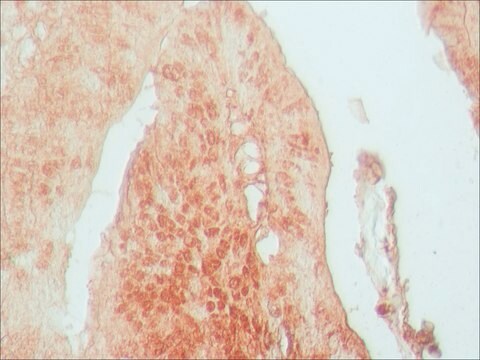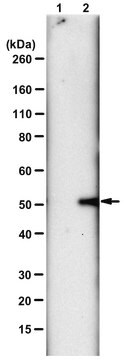ABS1670
Anti-Phosphohistidine (pHis)
from rabbit, purified by affinity chromatography
Synonyme(s) :
pHis, phosphohistidine
About This Item
ELISA
IP
WB
dot blot: suitable
immunoprecipitation (IP): suitable
western blot: suitable
Produits recommandés
Source biologique
rabbit
Niveau de qualité
Forme d'anticorps
affinity isolated antibody
Type de produit anticorps
primary antibodies
Clone
polyclonal
Produit purifié par
affinity chromatography
Espèces réactives
all, human, sheep, mouse
Technique(s)
ELISA: suitable
dot blot: suitable
immunoprecipitation (IP): suitable
western blot: suitable
Conditions d'expédition
ambient
Modification post-traductionnelle de la cible
phosphorylation (pHis )
Informations sur le gène
human ... PHPT1(29085)
Description générale
Spécificité
Immunogène
Application
Western Blotting Analysis: A 1:120 dilution from a representative lot detected proteins with histidine phosphorylation in sheep trachea cytosolic extract and human cell lysates, including 16HBE14o-, HEK293T, THP-1, and THP-1-derived macrophages (Courtesy of Bezaleel Mambwe, Richmond Muimo and RFW Jackson, Department of Infection, Immunity and Cardiovascular Disease/ Department of Chemistry, University of Sheffield, UK).
ELISA Analysis: A representative lot detected pHis- and pPza-, but not pTyr-, pSer-, pThr-, conjugated BSA or unconjugated BSA (Lilley, M., et al. (2015). Chem. Commun. (Camb). 51(34):7305-7308).
Immunoprecipitation Analysis: A representative lot immunoprecipitated proteins with histidine phosphorylation from ovine airway epithelia extract (Lilley, M., et al. (2015). Chem. Commun. (Camb). 51(34):7305-7308).
Western Blotting Analysis: A representative lot detected histidine phosphorylated proteins in 16HBE14o- human bronchial epithelial cell lysate and in ovine airway epithelia extract. Acid (0.1 M HCl or 0.4 M acetic acid/0.1 M hydroxylamine), but not alkaline (0.1 M NaOH), treatment of the lysates abolished targets bands detection (Lilley, M., et al. (2015). Chem. Commun. (Camb). 51(34):7305-7308).
Western Blotting Analysis: A representative lot detected histidine phosphorylation of immunoprecipitated NDPK-A/B from ovine airway epithelia extract, as well as G -R/M from 16HBE14o- human bronchial epithelial cell lysate (Lilley, M., et al. (2015). Chem. Commun. (Camb). 51(34):7305-7308).
Note: DO NOT HEAT SAMPLES prior to phosphohistidine detection. Histidine phosphorylation is heat and acid labile. To generate negative control for specificity test, an aliquot of sample can be heated at 95ºC for 10-15 minutes to reverse histidine phosphorylation. Alternatively, an aliquot of sample can be incubated under acidified pH at 37ºC for 15 minunites to reduce histidine phosphorylation. Acidify each 100 µL sample with 25 µL of 1 M HCl before the incubation, then neutralize with 25 µL of 1 M NaOH prior to phosphohistidine detection.
Signaling
Qualité
Western Blotting Analysis: A 1:200 dilution of this antibody detected histidine-phosphorylated proteins in 10 µg of HEK293 cell lysate.
Description de la cible
Forme physique
Stockage et stabilité
Autres remarques
Clause de non-responsabilité
Vous ne trouvez pas le bon produit ?
Essayez notre Outil de sélection de produits.
Code de la classe de stockage
12 - Non Combustible Liquids
Classe de danger pour l'eau (WGK)
WGK 1
Point d'éclair (°F)
Not applicable
Point d'éclair (°C)
Not applicable
Certificats d'analyse (COA)
Recherchez un Certificats d'analyse (COA) en saisissant le numéro de lot du produit. Les numéros de lot figurent sur l'étiquette du produit après les mots "Lot" ou "Batch".
Déjà en possession de ce produit ?
Retrouvez la documentation relative aux produits que vous avez récemment achetés dans la Bibliothèque de documents.
Notre équipe de scientifiques dispose d'une expérience dans tous les secteurs de la recherche, notamment en sciences de la vie, science des matériaux, synthèse chimique, chromatographie, analyse et dans de nombreux autres domaines..
Contacter notre Service technique







